fuel YAMAHA YZ250F 2005 Owners Manual
[x] Cancel search | Manufacturer: YAMAHA, Model Year: 2005, Model line: YZ250F, Model: YAMAHA YZ250F 2005Pages: 668, PDF Size: 15.74 MB
Page 6 of 668
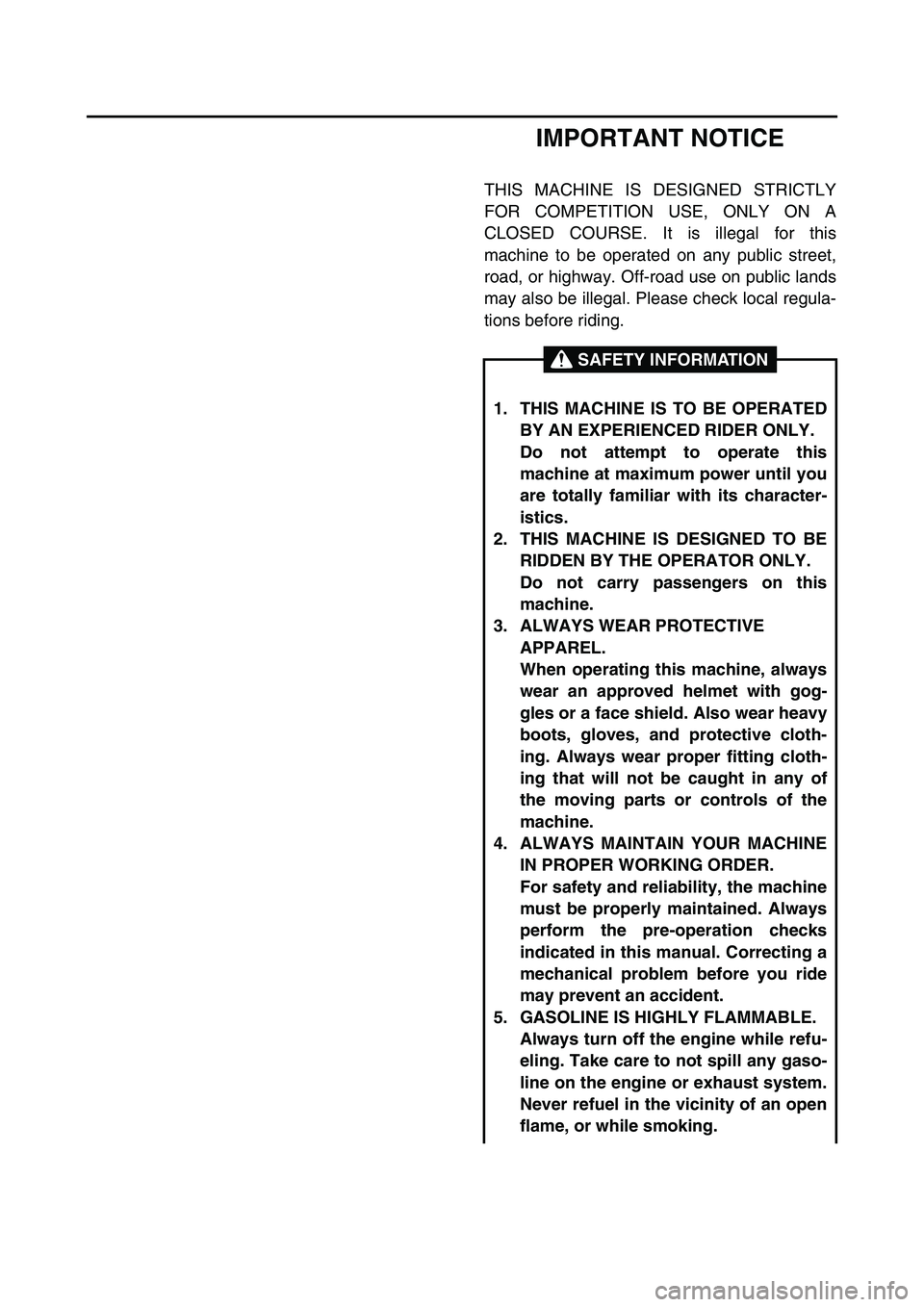
IMPORTANT NOTICE
THIS MACHINE IS DESIGNED STRICTLY
FOR COMPETITION USE, ONLY ON A
CLOSED COURSE. It is illegal for this
machine to be operated on any public street,
road, or highway. Off-road use on public lands
may also be illegal. Please check local regula-
tions before riding.
1. THIS MACHINE IS TO BE OPERATED
BY AN EXPERIENCED RIDER ONLY.
Do not attempt to operate this
machine at maximum power until you
are totally familiar with its character-
istics.
2. THIS MACHINE IS DESIGNED TO BE
RIDDEN BY THE OPERATOR ONLY.
Do not carry passengers on this
machine.
3. ALWAYS WEAR PROTECTIVE
APPAREL.
When operating this machine, always
wear an approved helmet with gog-
gles or a face shield. Also wear heavy
boots, gloves, and protective cloth-
ing. Always wear proper fitting cloth-
ing that will not be caught in any of
the moving parts or controls of the
machine.
4. ALWAYS MAINTAIN YOUR MACHINE
IN PROPER WORKING ORDER.
For safety and reliability, the machine
must be properly maintained. Always
perform the pre-operation checks
indicated in this manual. Correcting a
mechanical problem before you ride
may prevent an accident.
5. GASOLINE IS HIGHLY FLAMMABLE.
Always turn off the engine while refu-
eling. Take care to not spill any gaso-
line on the engine or exhaust system.
Never refuel in the vicinity of an open
flame, or while smoking.
SAFETY INFORMATION
Page 8 of 668
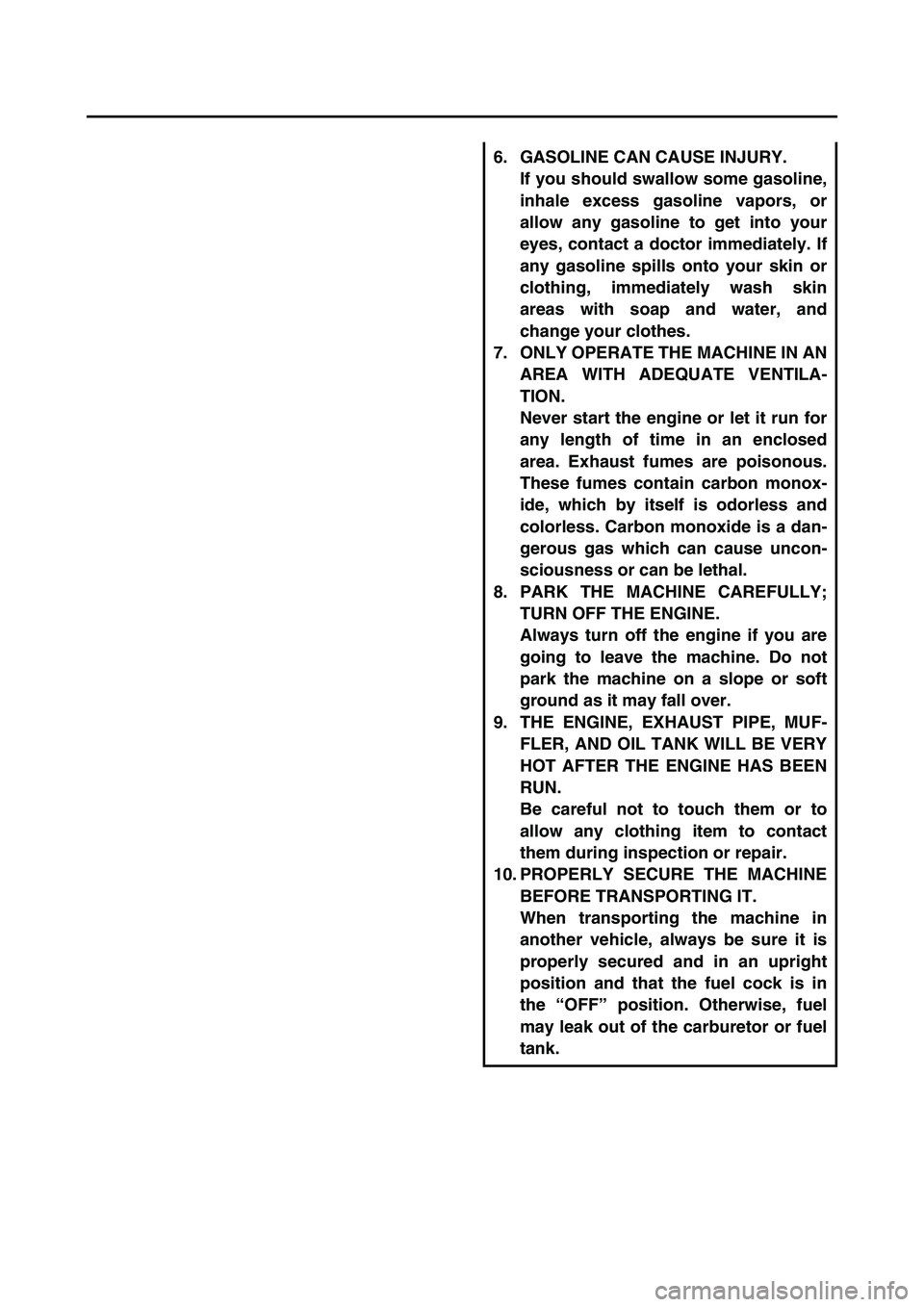
6. GASOLINE CAN CAUSE INJURY.
If you should swallow some gasoline,
inhale excess gasoline vapors, or
allow any gasoline to get into your
eyes, contact a doctor immediately. If
any gasoline spills onto your skin or
clothing, immediately wash skin
areas with soap and water, and
change your clothes.
7. ONLY OPERATE THE MACHINE IN AN
AREA WITH ADEQUATE VENTILA-
TION.
Never start the engine or let it run for
any length of time in an enclosed
area. Exhaust fumes are poisonous.
These fumes contain carbon monox-
ide, which by itself is odorless and
colorless. Carbon monoxide is a dan-
gerous gas which can cause uncon-
sciousness or can be lethal.
8. PARK THE MACHINE CAREFULLY;
TURN OFF THE ENGINE.
Always turn off the engine if you are
going to leave the machine. Do not
park the machine on a slope or soft
ground as it may fall over.
9. THE ENGINE, EXHAUST PIPE, MUF-
FLER, AND OIL TANK WILL BE VERY
HOT AFTER THE ENGINE HAS BEEN
RUN.
Be careful not to touch them or to
allow any clothing item to contact
them during inspection or repair.
10. PROPERLY SECURE THE MACHINE
BEFORE TRANSPORTING IT.
When transporting the machine in
another vehicle, always be sure it is
properly secured and in an upright
position and that the fuel cock is in
the “OFF” position. Otherwise, fuel
may leak out of the carburetor or fuel
tank.
Page 10 of 668
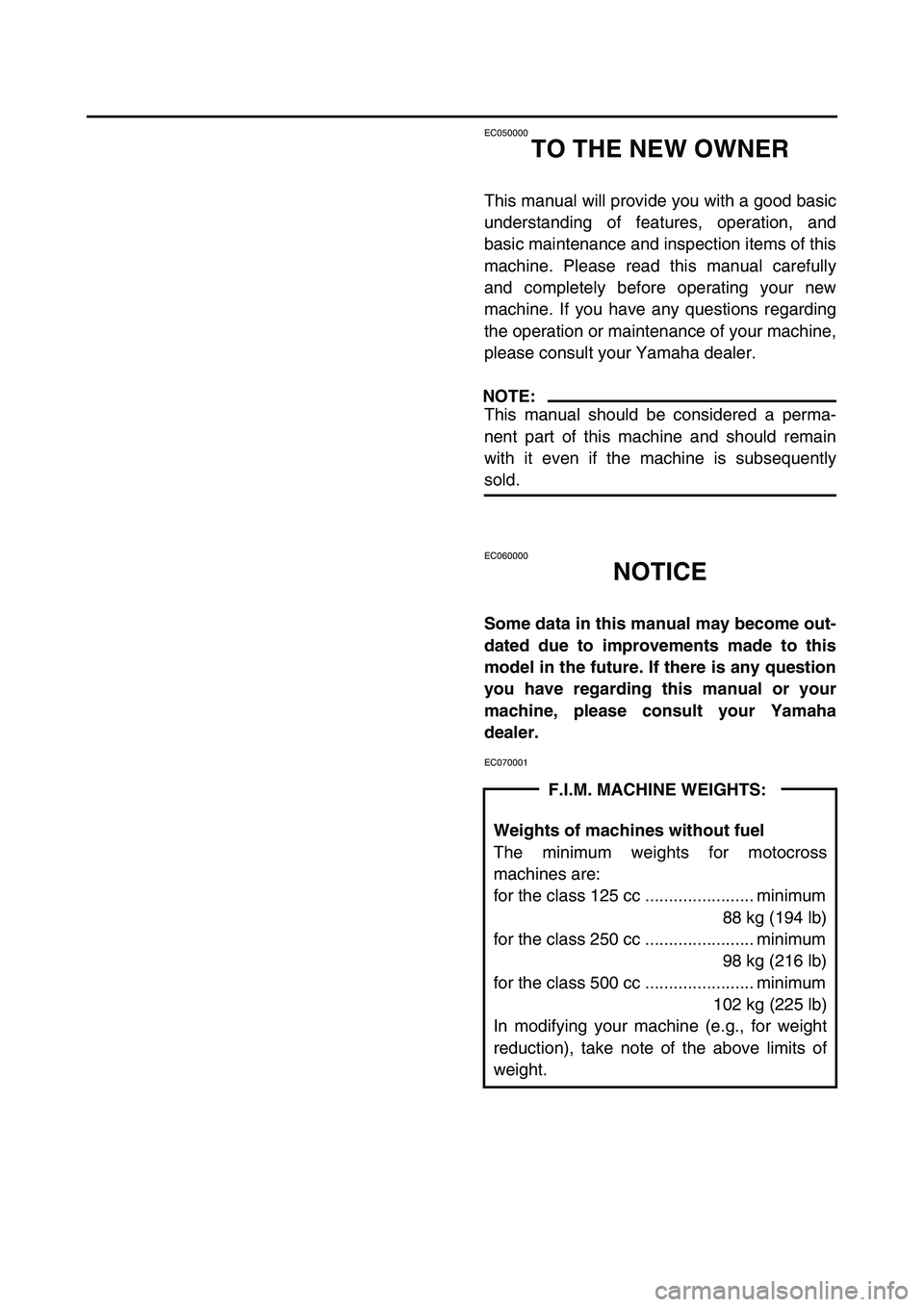
EC050000
TO THE NEW OWNER
This manual will provide you with a good basic
understanding of features, operation, and
basic maintenance and inspection items of this
machine. Please read this manual carefully
and completely before operating your new
machine. If you have any questions regarding
the operation or maintenance of your machine,
please consult your Yamaha dealer.
NOTE:
This manual should be considered a perma-
nent part of this machine and should remain
with it even if the machine is subsequently
sold.
EC060000
NOTICE
Some data in this manual may become out-
dated due to improvements made to this
model in the future. If there is any question
you have regarding this manual or your
machine, please consult your Yamaha
dealer.
EC070001
F.I.M. MACHINE WEIGHTS:
Weights of machines without fuel
The minimum weights for motocross
machines are:
for the class 125 cc ....................... minimum
88 kg (194 lb)
for the class 250 cc ....................... minimum
98 kg (216 lb)
for the class 500 cc ....................... minimum
102 kg (225 lb)
In modifying your machine (e.g., for weight
reduction), take note of the above limits of
weight.
Page 20 of 668
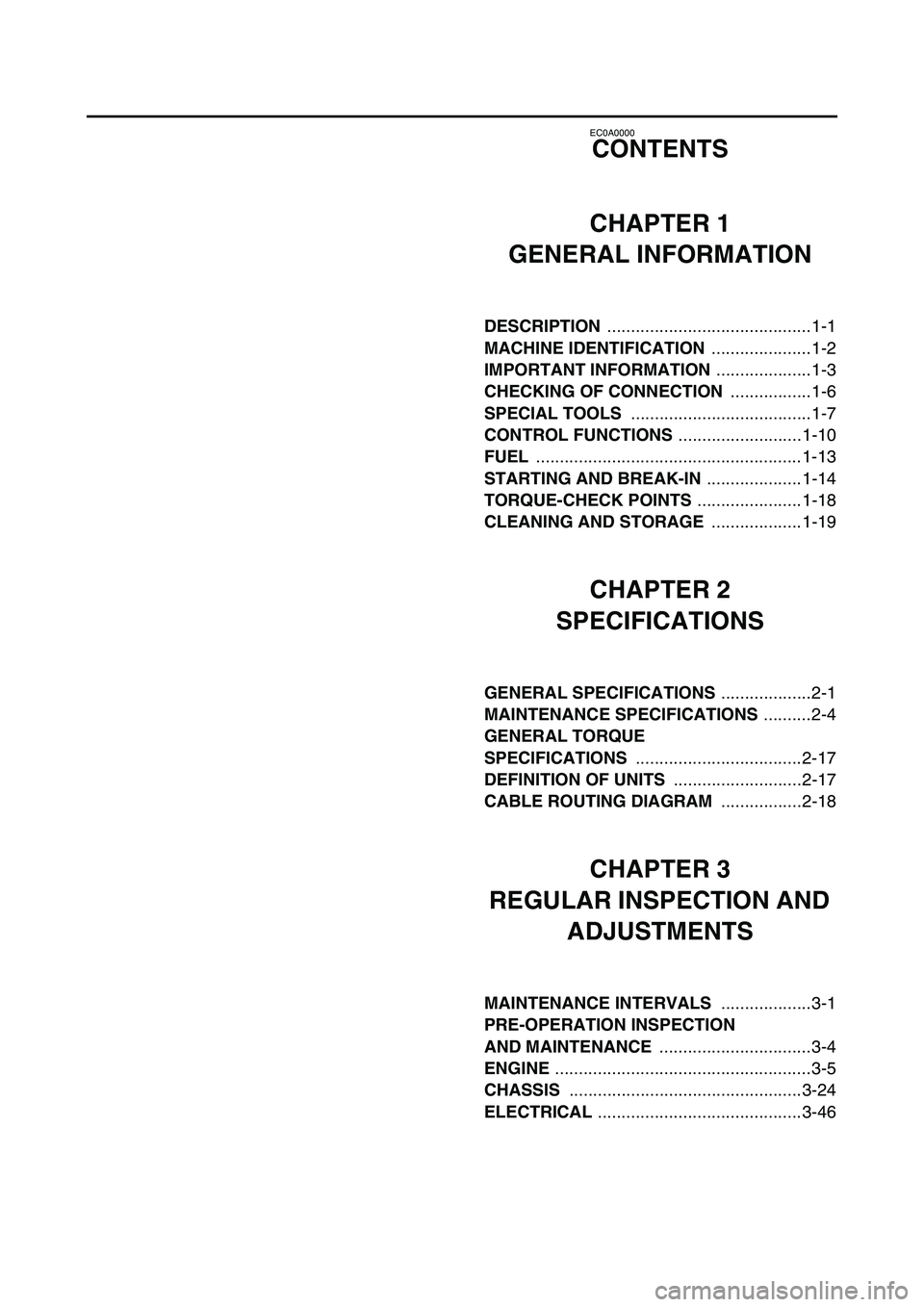
EC0A0000
CONTENTS
CHAPTER 1
GENERAL INFORMATION
DESCRIPTION
...........................................1-1
MACHINE IDENTIFICATION
.....................1-2
IMPORTANT INFORMATION
....................1-3
CHECKING OF CONNECTION
.................1-6
SPECIAL TOOLS
......................................1-7
CONTROL FUNCTIONS
..........................1-10
FUEL
........................................................1-13
STARTING AND BREAK-IN
....................1-14
TORQUE-CHECK POINTS
......................1-18
CLEANING AND STORAGE
...................1-19
CHAPTER 2
SPECIFICATIONS
GENERAL SPECIFICATIONS
...................2-1
MAINTENANCE SPECIFICATIONS
..........2-4
GENERAL TORQUE
SPECIFICATIONS
...................................2-17
DEFINITION OF UNITS
...........................2-17
CABLE ROUTING DIAGRAM
.................2-18
CHAPTER 3
REGULAR INSPECTION AND
ADJUSTMENTS
MAINTENANCE INTERVALS
...................3-1
PRE-OPERATION INSPECTION
AND MAINTENANCE
................................3-4
ENGINE
......................................................3-5
CHASSIS
.................................................3-24
ELECTRICAL
...........................................3-46
Page 22 of 668
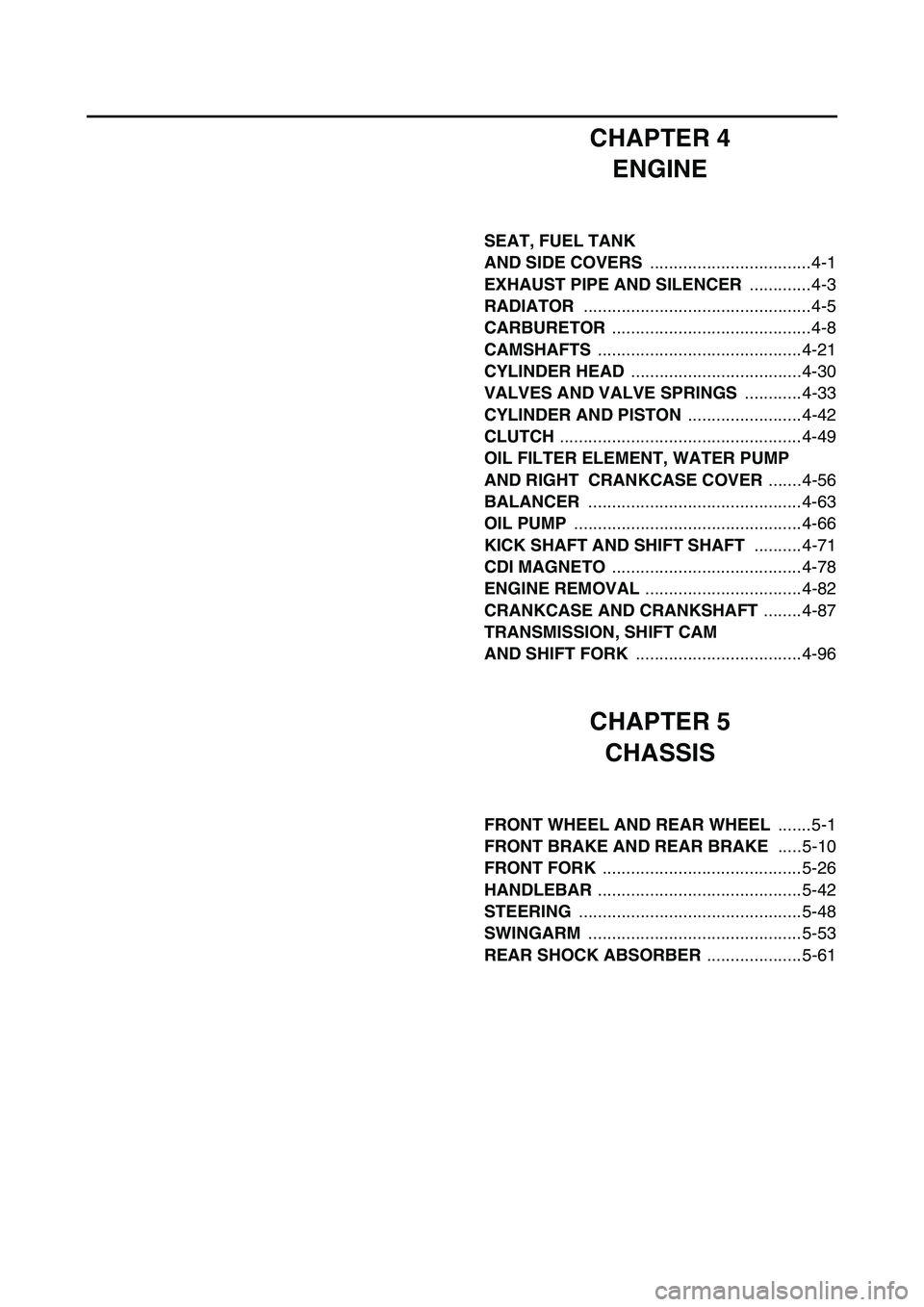
CHAPTER 4
ENGINE
SEAT, FUEL TANK
AND SIDE COVERS ..................................4-1
EXHAUST PIPE AND SILENCER .............4-3
RADIATOR ................................................4-5
CARBURETOR ..........................................4-8
CAMSHAFTS ...........................................4-21
CYLINDER HEAD ....................................4-30
VALVES AND VALVE SPRINGS ............4-33
CYLINDER AND PISTON ........................4-42
CLUTCH ...................................................4-49
OIL FILTER ELEMENT, WATER PUMP
AND RIGHT CRANKCASE COVER .......4-56
BALANCER .............................................4-63
OIL PUMP ................................................4-66
KICK SHAFT AND SHIFT SHAFT ..........4-71
CDI MAGNETO ........................................4-78
ENGINE REMOVAL .................................4-82
CRANKCASE AND CRANKSHAFT ........4-87
TRANSMISSION, SHIFT CAM
AND SHIFT FORK ...................................4-96
CHAPTER 5
CHASSIS
FRONT WHEEL AND REAR WHEEL .......5-1
FRONT BRAKE AND REAR BRAKE .....5-10
FRONT FORK ..........................................5-26
HANDLEBAR ...........................................5-42
STEERING ...............................................5-48
SWINGARM .............................................5-53
REAR SHOCK ABSORBER ....................5-61
Page 26 of 668
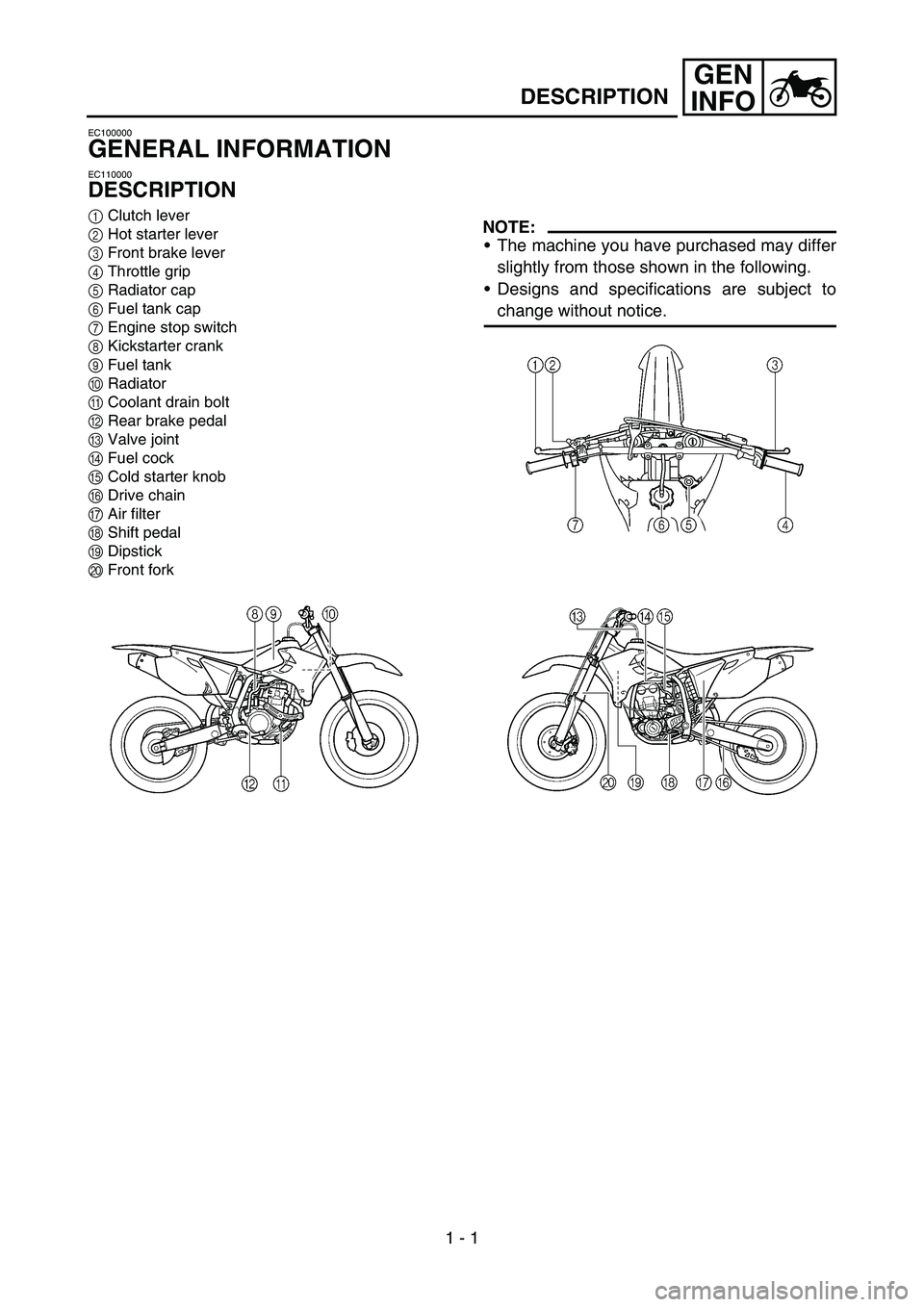
GEN
INFO
1 - 1
DESCRIPTION
EC100000
GENERAL INFORMATION
EC110000
DESCRIPTION
1Clutch lever
2Hot starter lever
3Front brake lever
4Throttle grip
5Radiator cap
6Fuel tank cap
7Engine stop switch
8Kickstarter crank
9Fuel tank
0Radiator
ACoolant drain bolt
BRear brake pedal
CValve joint
DFuel cock
ECold starter knob
FDrive chain
GAir filter
HShift pedal
IDipstick
JFront forkNOTE:
The machine you have purchased may differ
slightly from those shown in the following.
Designs and specifications are subject to
change without notice.
Page 52 of 668
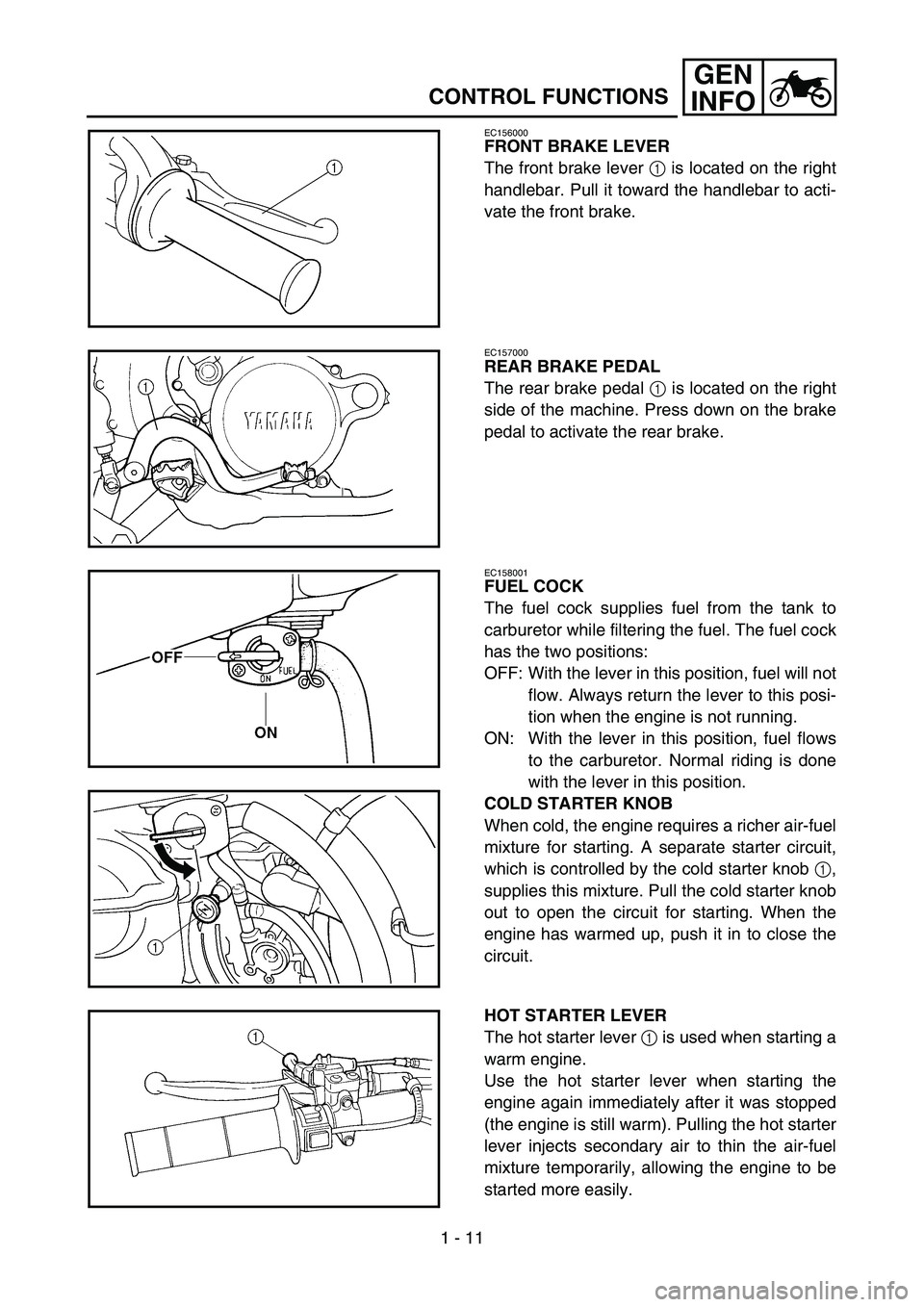
1 - 11
GEN
INFO
CONTROL FUNCTIONS
EC156000
FRONT BRAKE LEVER
The front brake lever 1 is located on the right
handlebar. Pull it toward the handlebar to acti-
vate the front brake.
EC157000
REAR BRAKE PEDAL
The rear brake pedal 1 is located on the right
side of the machine. Press down on the brake
pedal to activate the rear brake.
EC158001
FUEL COCK
The fuel cock supplies fuel from the tank to
carburetor while filtering the fuel. The fuel cock
has the two positions:
OFF: With the lever in this position, fuel will not
flow. Always return the lever to this posi-
tion when the engine is not running.
ON: With the lever in this position, fuel flows
to the carburetor. Normal riding is done
with the lever in this position.
COLD STARTER KNOB
When cold, the engine requires a richer air-fuel
mixture for starting. A separate starter circuit,
which is controlled by the cold starter knob 1,
supplies this mixture. Pull the cold starter knob
out to open the circuit for starting. When the
engine has warmed up, push it in to close the
circuit.
HOT STARTER LEVER
The hot starter lever 1 is used when starting a
warm engine.
Use the hot starter lever when starting the
engine again immediately after it was stopped
(the engine is still warm). Pulling the hot starter
lever injects secondary air to thin the air-fuel
mixture temporarily, allowing the engine to be
started more easily.
Page 54 of 668

1 - 12
GEN
INFO
CONTROL FUNCTIONS
EC15R001
DETACHABLE SIDESTAND
This sidestand 1 is used to support only the
machine when standing or transporting it.
WARNING
Never apply additional force to the side-
stand.
Remove this sidestand before starting
out.
EC15F000
VALVE JOINT
This valve joint 1 prevents fuel from flowing
out and is installed to the fuel tank breather
hose.
CAUTION:
In this installation, make sure the arrow
faces the fuel tank and also downward.
SPARK PLUG WRENCH
This spark plug wrench 1 is used to remove
and install the spark plug.
1
1
NIPPLE WRENCH
This nipple wrench 1 is used to tighten the
spoke.
Page 56 of 668
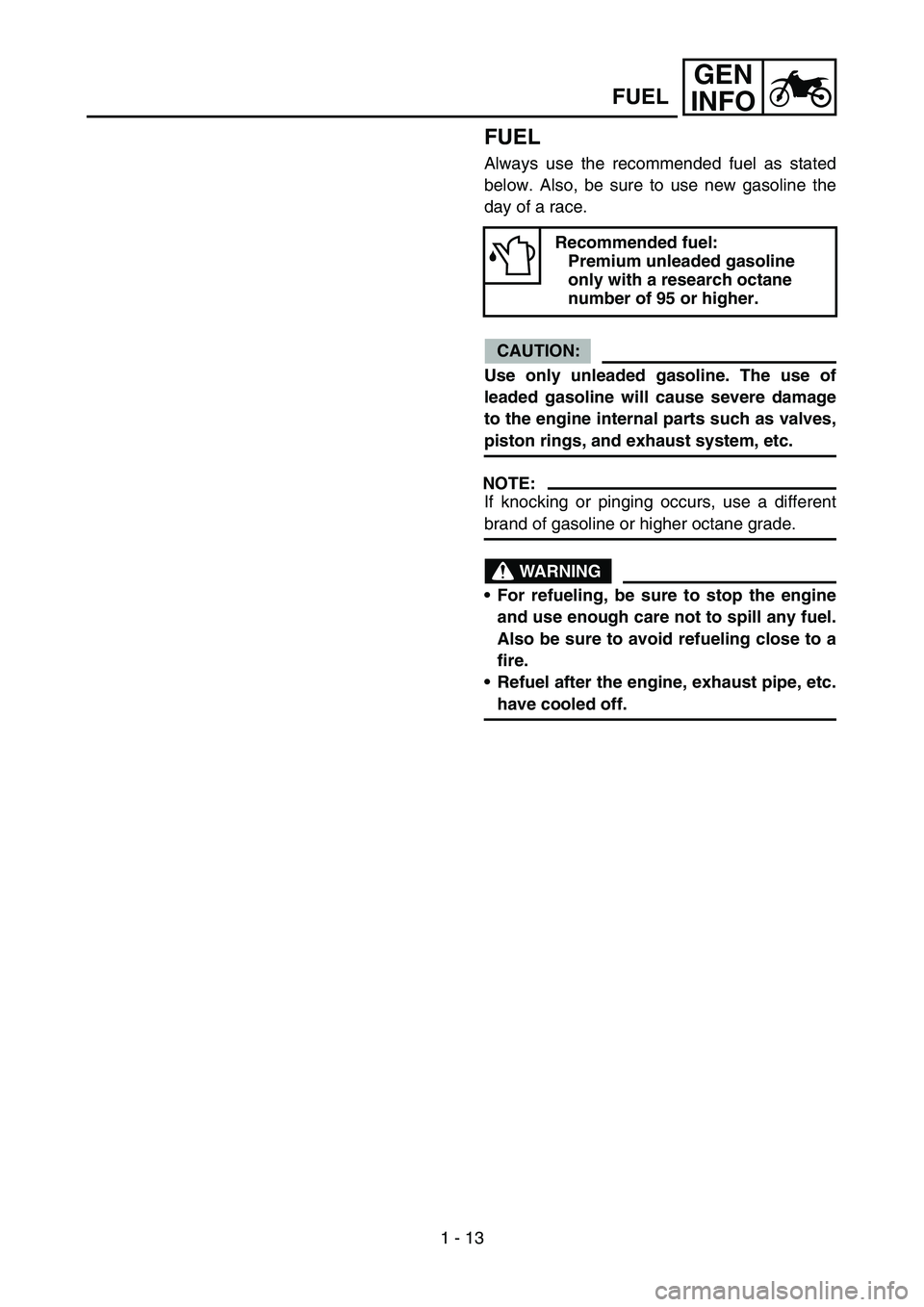
1 - 13
GEN
INFO
FUEL
Always use the recommended fuel as stated
below. Also, be sure to use new gasoline the
day of a race.
CAUTION:
Use only unleaded gasoline. The use of
leaded gasoline will cause severe damage
to the engine internal parts such as valves,
piston rings, and exhaust system, etc.
NOTE:
If knocking or pinging occurs, use a different
brand of gasoline or higher octane grade.
WARNING
For refueling, be sure to stop the engine
and use enough care not to spill any fuel.
Also be sure to avoid refueling close to a
fire.
Refuel after the engine, exhaust pipe, etc.
have cooled off.
Recommended fuel:
Premium unleaded gasoline
only with a research octane
number of 95 or higher.
FUEL
Page 58 of 668
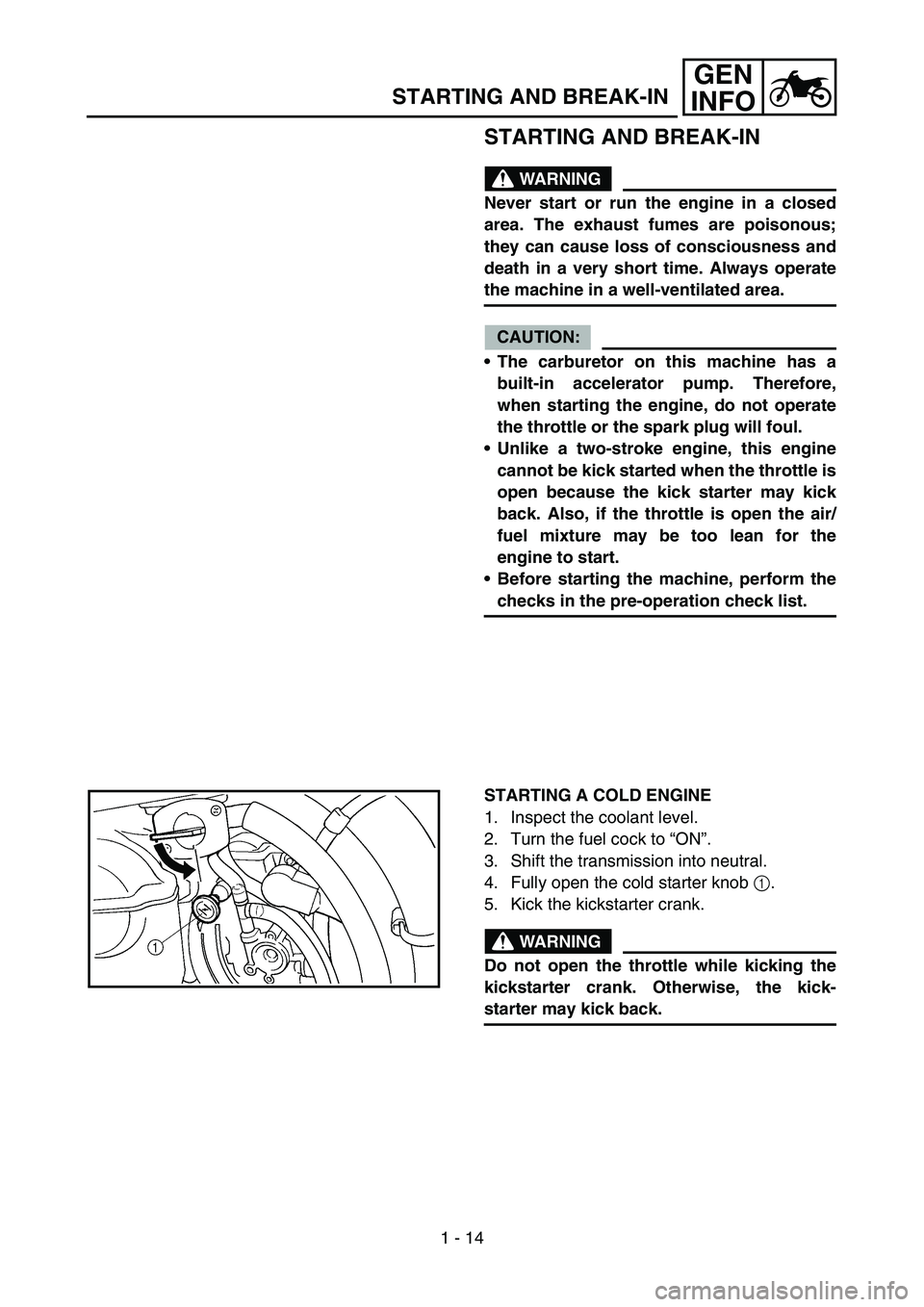
1 - 14
GEN
INFO
STARTING AND BREAK-IN
WARNING
Never start or run the engine in a closed
area. The exhaust fumes are poisonous;
they can cause loss of consciousness and
death in a very short time. Always operate
the machine in a well-ventilated area.
CAUTION:
The carburetor on this machine has a
built-in accelerator pump. Therefore,
when starting the engine, do not operate
the throttle or the spark plug will foul.
Unlike a two-stroke engine, this engine
cannot be kick started when the throttle is
open because the kick starter may kick
back. Also, if the throttle is open the air/
fuel mixture may be too lean for the
engine to start.
Before starting the machine, perform the
checks in the pre-operation check list.
STARTING A COLD ENGINE
1. Inspect the coolant level.
2. Turn the fuel cock to “ON”.
3. Shift the transmission into neutral.
4. Fully open the cold starter knob 1.
5. Kick the kickstarter crank.
WARNING
Do not open the throttle while kicking the
kickstarter crank. Otherwise, the kick-
starter may kick back.
STARTING AND BREAK-IN